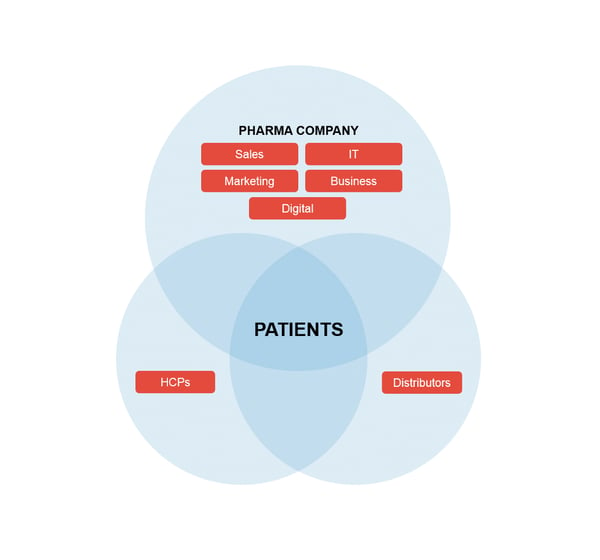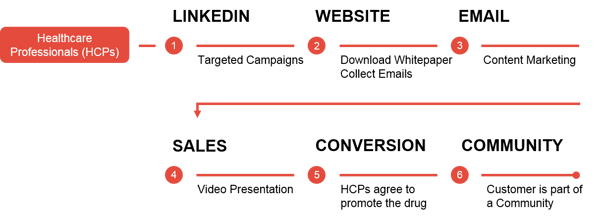Although in the last years the pharma industry has been slow to adapt to the digital transformation, there is a huge focus on it now that also spans across the pharma value chain — sales, marketing, digital, business, IT and extends to patients, HCPs and distributors. In the spotlight are the many existing opportunities for improving performance by better connecting digitally with patients and HCPs.
How to create a collaborative ecosystem to serve patients
From my perspective, the Digital Transformation in Pharma should enable organizations to blend the digital with the sales representatives to deliver personalized and relevant experiences to all their audiences starting from patients, HCPs, distributors and partners. If pharma companies want to join the digital transformation, it is important to leverage AI algorithms, use connected IoT healthcare devices, and draw meaningful insights from the massive amount of existing generated electronic data.
In order for pharma brands to engage the customers, a shift in the organisational paradigm would have to occur, from working in silos to a collaborative work. And it’s no secret that successful companies have a customer-centric strategies. Digital transformation should also include efficient operational processes because the most successful organisations deliver superior customer value by engineering agility into every aspect of business operations.
Shifting and Uniting
In the pharma industry, the end-customer is of course the patient. All efforts should be put into fulfilling the patients’ needs and expectations, by creating an ecosystem that enables pharma companies to achieve their digital potential. This would look something like the image below:
Empower and engage the patient
Pharma organizations need to be on the same page and have the common goal to engage on the one hand the HCPs and distributors in order to deliver quality services and products to patients and on the other hand to directly engage patients through mobile apps, wearables, chatbots, smart speakers, OTC etc. You can think of it as a B2B2C and B2C model.
It’s not an easy job, but creating and maintaining this digital ecosystem will be the responsibility of the pharma companies, as in the end the customer experience is the one that counts within a business. And in 2018, CX is the buzzword present on everyone’s lips and represents the touchpoints during the entire customer journey and relationship. According to experts, customer experience (CX) is “the next competitive battleground” that will stand as a measure of business success.
Life sciences companies are willing to embrace digital transformation for a more patient-centric care and the patients are the ones who are driving this change. Patients now have greater access to their personal health information online and are more educated and play an active role in their care. Healthcare has moved from fee-for-service to value-based care, and both patients and payers are expecting personalized, cost-effective treatments with proven outcomes.
The shift I see is from the sick-care business towards well-care business becoming Digital health-care providers.
Customer journeys are highly strategic, and in such a regulated and competitive environment such as life sciences, the effort invested can make or break the success of a new drug launch. For pharma, defining the “customer” is already a complex process. While patients are the end consumers, pharma companies have a more direct relationship with health care providers (HCPs), who unquestionably influence the patient and determine the successful marketing of medications.
This is how a customer journey would look like in the pharma digital ecosystem:

1. The pharma company engages the HCP through a LinkedIn campaign for a new diabetes drug.
2. The HCP accesses a dedicated landing page where he/she can read more about the drug benefits.
- If the HCP is interested, he/she can download a more detailed whitepaper from the same landing page, containing the results the drug trial. In order to do that, the site requests and email address, but it also collects the cookies for those who landed on the page, even if they didn’t download the file.
3. The Pharma company re-engages the HCP that downloaded the white paper, by sending a thread of 3 emails, each with a short video content with top healthcare professionals around the world sharing insightful knowledge and content on the topic.
- It’s a first step for them to understand that the pharma company is not only trying to sell its drugs, but rather to educate and to create a community where healthcare professionals share their ideas and learn from each other, and they get to understand what’s important for patients too.
4. For those who opened all 3 emails and watched the videos, the pharma company sends another email asking if they are interested in speaking with a sales rep about the drug and its benefits for the patients.
- If an HCP is interested, a remote session is scheduled. During the remote video conference, the Pharma specialist will present the particularities of the drug, the monitoring app that comes with it and all the advantages it can bring for the patients.
- This is the step were Sales representatives step in. They have access to the entire journey of the HCP with the Pharma brand and have 360-degree view of the customer. This will help the sales rep to persuade the HCPs of the quality delivered by the brand.
5. The HCP agrees to promote the drug.
6. The health care professional is now part of the community and can join monthly online meetings with peers, and can access premium reports on diabetes etc. The whole experience will help the pharma company to create more awareness of the product, nevertheless to engage and create a close relationship with the HCPs and in the end to bring value to the patients.
The funnel can go further also for visitors who didn’t take any action on the landing page, and based on the collected cookies, pharma companies can do remarketing campaigns.
Of course, implementing a digital transformation strategy is not an easy job for the organization, and one of the biggest challenges in pharma is the sales representatives’ reluctance towards the digitalization process, thinking that they might contribute less to the brand.
Is the battle between the sales representatives and digital standing in the way of transformation?
I believe the real question should be: Is there really a battle? As mentioned, the purpose of digital transformation is not to disrupt the workforce but to help employees work together, to ultimately serve the customers/patients and fulfill their needs.
A digital transformation program should facilitate the work of the sales representatives and deliver the following items:
- Real-time customer insight
- 360-degree view of the customer
- Contract management
- Account management
- Products, promotions and offers
- Predictive analytics
- Order management and many more.
The purpose is to offer the sales representatives the necessary means to acquire new clients or to retain existing ones, through optimized digital processes that will assist them in their jobs. Face-to-face meetings are still an important part of the pharma industry and a collaboration between the online and offline channels would only increase the success rate.
What makes a Digital Transformation successful?
1. It all starts with cultivating an agile mindset in the organization, an organization that has the digital written into its DNA and is ready to face the never-ending technology and business challenges.
2. An agile mindset will most definitely enable operations to be more efficient through agile and automated processes that will reduce costs and improve the overall brand experience.
3. Of course all of these processes must be backed up by technology, a powerful digital transformation platform might come at hand and help the organizations to create the digital ecosystem that I’ve mentioned earlier.
4. Nevertheless, the digital ecosystem must be able to adapt and develop its own strategies that will keep it competitive on the market (brand management, portfolio and innovation etc.).
5. All of the above points aim to offer a personalized customer experience that satisfy the patients’ needs and engage him in the digital ecosystem.
Looking into the future
As technology is blooming, so are the opportunities for pharma.
The rise of IoE allows pharma companies to broaden their product portfolio by providing smart connected devices that will improve patient care (e.g. senior monitoring devices or blood glucose monitoring devices & apps).
The chatbot and smart speakers revolution is going to be a great opportunity for the pharma industry by improving patients’ lives. For example, while attending the Digital Pharma Europe 2018 conference in London this year, I’ve seen a chatbot in action helping people with Alzheimer’s disease improve their day-to-day activities, acting as a personal assistant.
Smart speakers (such as Siri, Alexa, Cortana etc.) have the potential to grow even more in the following years and the younger generations will definitely be more accustomed to using voice interfaces in the future, so they will naturally be targeted through this channel.
In the following years, customer experience as we know it will be transformed in a very disruptive way through innovation and technology and this will be a chance for pharma companies to become Digital Healthcare Providers, if of course, the organizations have a digital mindset in their organizational DNA.
It’s also important to mention that big technology companies such as Apple or Google see a golden opportunity across healthcare, aligned with their business model. Pharma must learn how to take advantage of this trend and how to use their potential to bring more value to their business using all their expertise. If pharma companies fail in actively investigating the opportunities, in the end, they will run the risk of missing differentiating partnership opportunities or disruptive innovations.
Originally published here.





